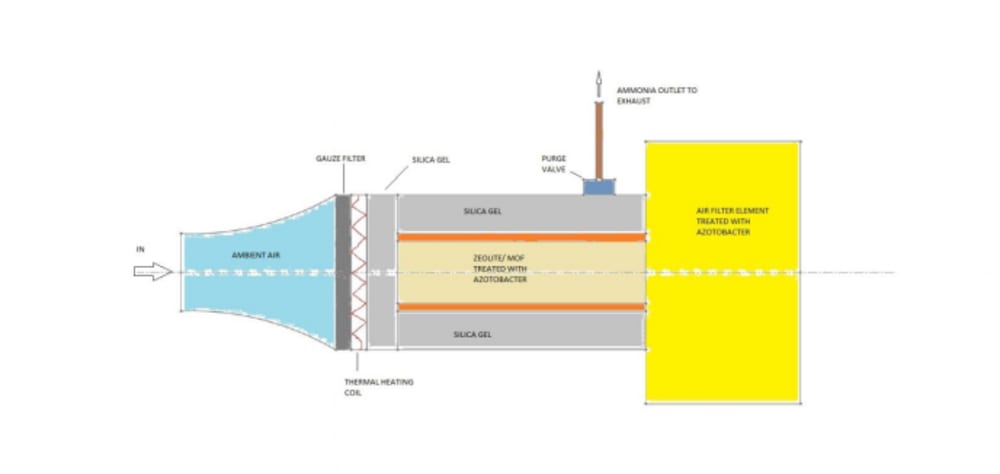Brake Horse Power (BHP) and Brake Specific Fuel Consumption (BSFC) are few parameters which are taken into account while designing an engine. Power to be produced in the engine needs specific fuel consumption, basis the calorific value of the fuel. For extracting maximum power from the combustion process, it is intended that all the fuel is completely burned. Ambient air consists of 79% Nitrogen and 21% Oxygen. Thus, for complete combustion to occur, number of oxygen molecules available in the intake air poses as a design constraint.
In this paper, an innovative method has been suggested which increases the percentage of available oxygen in the intake air by physically adsorbing and biologically fixing available nitrogen. Thus one could either extract maximum power or has an option to downsize engines.
The module as shown in the illustration consists of adsorbent bed usually zeolite/metal organic frameworks (MOF) like Basolite for physical adsorption of nitrogen. Study is being carried out to ascertain the amount of nitrogen being physically adsorbed in zeolite/ MOF under normal operating conditions. Further another area of research is to treat the adsorbent bed with bio inoculant (Azotobacter) to aid biological fixatation of nitrogen.
To enhance the amount of nitrogen to be biologically fixed, it is proposed to treat the filtering element of air filter with bio inoculant (Azotobacter). Thus, nitrogen available in ambient air is removed both by physical adsorption and biological fixatation and thus air entering into the engine cylinder is enriched with oxygen.
The module has a diverging cone entrant to enhance the local pressure of incoming air. A gauze filter is provided at the entry to filter out macro dust particles present in the air. A thermal coil or heating coil is placed beyond the gauze filter. The purpose of thermal coil is to aid desorption when the adsorbent bed gets saturated.
Silica gel layer is placed after the thermal coil to absorb water vapour present in the ambient air. The dry air passes through the adsorbent bed i.e., zeolite/ basolite.
Layers of adsorbent bed are structured in the module. One of the layers is treated with bio inoculant (Azotobacter). Different variants of Azotobacter are available, some just fix the nitrogen and others convert the fixed nitrogen to Ammonia. Ammonia thus formed due to conversion of biologically fixed nitrogen is less dense than air and thus rises up and is adsorbed by silica gel. Adsorbed ammonia is
conveyed to the exhaust pipe through purge valve. Purge valve is operated basis engine temperature as NOx emissions are formed at high temperatures. Thus when the engine cylinder temperature is high, the purge valve is operated and adsorbed ammonia is conveyed to the exhaust pipe. Ammonia when fed to hot exhaust gases break down NOx into nitrogen and oxygen. Further, to increase the amount of biologically fixed nitrogen, the filtering element of air filter is treated with bio inoculant, Azotobacter, with a variant which biologically fixes nitrogen and does not convert it into ammonia.
Like this entry?
-
About the Entrant
- Name:Sindavalam Sharath
- Type of entry:individual
- Patent status:none


